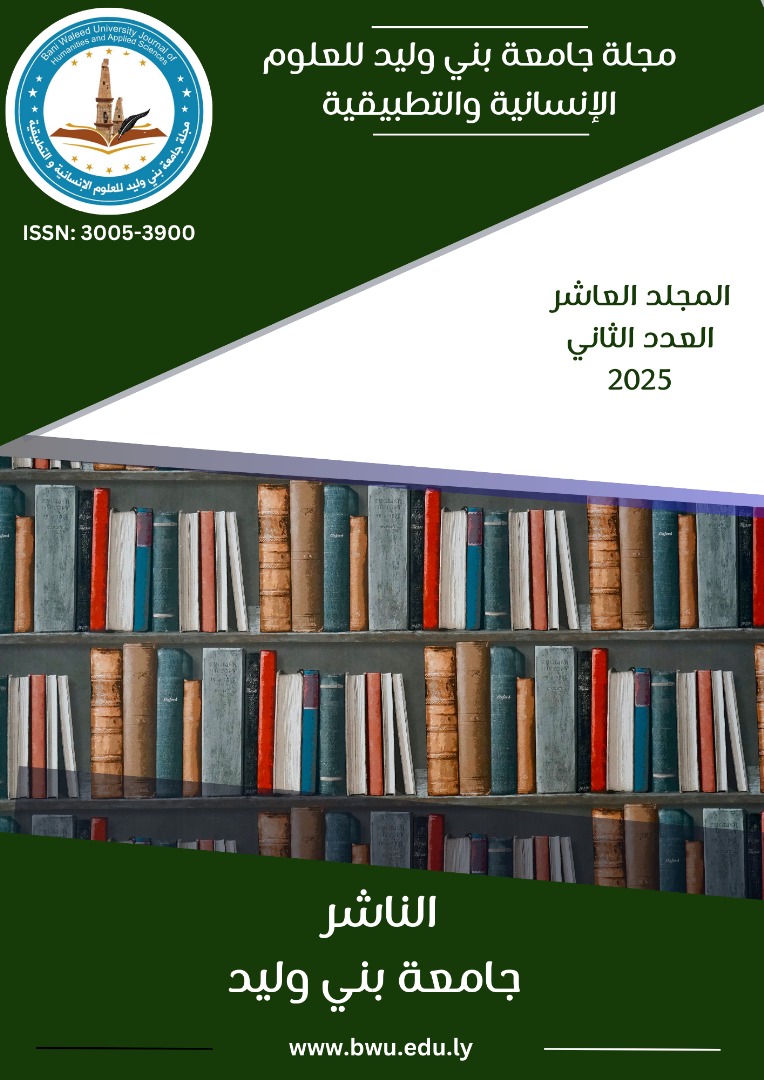تقييم تأثير عمليات غربلة القمح في الحد من انتشار الحشائش في منطقة الجبل الأخضر، ليبيا
DOI:
https://doi.org/10.58916/jhas.v10i2.772الكلمات المفتاحية:
الجبل الأخضر، الغربلة، تنوع الحشائش، زراعة القمح، الطرق التقليديةالملخص
إن نواتج غربلة القمح تعد مصدر متنوعا للحشائش مما يعني إمكانية انتقالها مع تقاوي نباتات القمح أثناء غربلة القمح مما يسبب نقص هائل في محصول الحبوب. لذا يجب على برامج مكافحة الحشائش اعطاء اهتمام أكبر لعمليات غربلة وتنقية البذور قبل زراعتها. في حين ركزت هذه الدراسة على الطرق التقليدية، فإن الأدبيات الحديثة تُظهر إمكانية تطوير منهجية البحث مستقبلًا عبر دمج تقنيات الذكاء الاصطناعي مع الطرق التقليدية (Smith et al., 2023) اُستخدم في هذه الدراسة خمس عينات قمح أخذت من مزارع موثوقة بالجبل الأخضر في الموسم الزراعي 2023/2024 وزن كل عينة حوالي250 جرام خضعت العينات لعملية الغربلة في مختبر قسم المحاصيل باستخدام غربال 2 ملم و من ثم زراعتها في أواني زراعية سعة( 60*90 و عمق 30 سم) مملؤة بتربة معقمة تم أضافة نواتج الغربلة للأواني الزراعية بأوزان مختلفة بواقع (0,2.5,5,7.5,10) جرام لكل أصيص في ظروف معملية أُستخدم في تصميم التجربة تصميم القطاعات كاملة العشوائية في ثلاث مكررات لتقييم كثافة و تنوع بذور الحشائش المنتقلة مع تقاوي محصول القمح وحساب مؤشرات التنوع مثل مؤشر شانون و مؤشر بيبلو و تحليل التباين باستخدام برنامج SAS . أظهرت النتائج تنوعًا كبيرا في الحشائش وكلما زادت نواتج الغربلة ازداد التنوع، و قد سجلت النتائج المتحصل عليها هيمنة العليق Convolvulu arvensis وتكرارها بعدد كبير في كل المعاملات تليها الحارة أو الفجل البري Brassica compestris وذيل الفار Lecanora escylenta والجلبان Lathyrus sativus و كان أقلها تكرار سيار أو سفناري الحمار Fumaria densiflora..
التنزيلات
المراجع
Amare, A., Tesfaye, K., & Lemma, B. (2014). Weed flora and their interference in wheat (Triticum aestivum L.) at Adet area, Amhara Region, Ethiopia. Journal of Agricultural Science, 6(1), 1–10. https://doi.org/10.5539/jas.v6n1p1
Burkov, V. I., Tkachuk, O. V., & Kovalchuk, S. I. (2018). Weed seed contamination in harvested grain and its impact on crop yield. Ukrainian Journal of Ecology, 8(3), 234–242.
Chicouene, P. (2020). Integrated weed management in wheat: A review. Journal of Agricultural Science, 12(2), 1–15. https://doi.org/10.5539/jas.v12n2p1
Das, A. K. (2008). Weed management in wheat: A review. Indian Journal of Weed Science, 40(1), 1–10.
Asmaa Al-Mabrouk Abdel-Sayed, Fatima Faraj Mohamed, Najwa Mohamed, & Fatima Khamis. (2023). Performance evaluation of some genotypes of double-row barley (Hordeum vulgare L.) under rainfed conditions in the Green Mountain region of Libya. Bani Waleed University Journal for Humanities and Applied Sciences, 8(2), 453-473.
Food and Agriculture Organization of the United Nations. (2025). FAO homepage. https://www.fao.org
Gharde, S. S., Patil, S. S., & Patil, P. S. (2018). Weed flora and their interference in wheat (Triticum aestivum L.) in Vidarbha region of Maharashtra. Journal of Pharmacology and Phytochemistry, 7(1), 1–5.
Hossain, M. A. (2015). Integrated weed management in wheat: A sustainable approach. Journal of Agronomy, 14(3), 121–128.
ISWS (International Survey of Weed Seeds). (2018). Weed seed contamination in crop seeds: A global perspective (Vol. 15, pp. 1–100). International Survey of Weed Seeds.
Kumar, V. (2014). Weed seed contamination in harvested grain: A review. Journal of Crop Science and Biotechnology, 17(2), 101–110.
Lollato, R. P., Holman, J. D., & Jhala, A. J. (2020). Weed seed return to the soil and its implications for wheat production. Crop Science, 60(2), 651–662. https://doi.org/10.1002/csc2.20051
Norsworthy, J. K., Oliver, S. R., & Bond, J. D. (2012). Integrated weed management: Principles and practices. Weed Science, 60(2), 167–178. https://doi.org/10.1614/WS-D-11-00061.1
Oerke, E. C. (2006). Crop losses to pests. Journal of Agricultural Science, 144, 31–43. https://doi.org/10.1017/S0021859606006043
Jamal Saeed Dariaq, Abdul Qader Mohammed Abu Jadida, & Mohammed Fathallah Al-Hassi. (2024). Pollution of some groundwater wells in the city of Al-Marj with some heavy elements and nitrates. Journal of Bani Waleed University for Humanities and Applied Sciences, 9(5), 457-464.
Owen, M. D. K., & Powles, S. B. (2020). The global threat of herbicide-resistant weeds. Trends in Plant Science, 25(10), 1003–1015. https://doi.org/10.1016/j.tplants.2020.07.003
Pisal, V. S., & Sagarka, D. D. (2013). Effectiveness of seed cleaning methods in reducing weed seed contamination in wheat (Triticum aestivum L.). Indian Journal of Weed Science, 45(1), 1–6.
Pradhan, P., & Chakraborti, A. (2010). Integrated weed management in wheat: A review. Indian Journal of Agronomy, 55(2), 101–108.
SAS Institute Inc. (2021). SAS/STAT® 15.2 user’s guide. SAS Institute Inc.
Walker, S. (1995). Weed seed contamination in harvested grain: Implications for crop production. Weed Research, 35(3), 201–210. https://doi.org/10.1111/j.1365-3180.1995.tb01823.x
Sabah Musa Abdul Majeed, Zakia Fadel Mansour, & Fatima Muhammad Younis. (2024). A study of the effect of fertilization with different rates of nitrogen and phosphorus on the percentage and quantity of volatile oil yield and the total chlorophyll content of leaves of marjoram plant Majorana hortensis moench growing under the conditions of the Green Mountain region. Journal of Bani Waleed University for Humanities and Applied Sciences, 490-504.
Zhang, L., et al. (2023). Deep learning-based weed detection in wheat fields. Nature Agriculture, 7(2), 112–125. https://doi.org/10.1038/s44100-023-00142-w
Wang, H., et al. (2022). UAVs for weed mapping. Remote Sensing, 14(3), 550. https://doi.org/10.3390/rs14030550
Food and Agriculture Organization of the United Nations. (2024). Climate-smart weed management. https://www.fao.org
Smith, J., et al. (2023). AI-based seed sorting: A revolution in weed management. Nature Agriculture, 7(2), 45–60. https://doi.org/10.1038/s44100-023-00120-2













